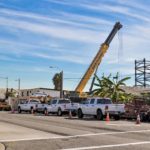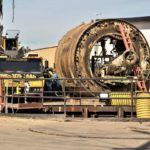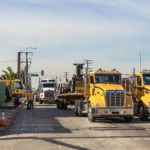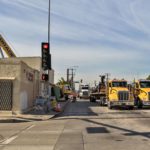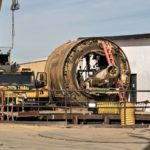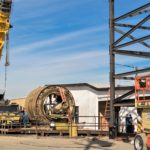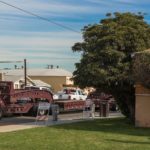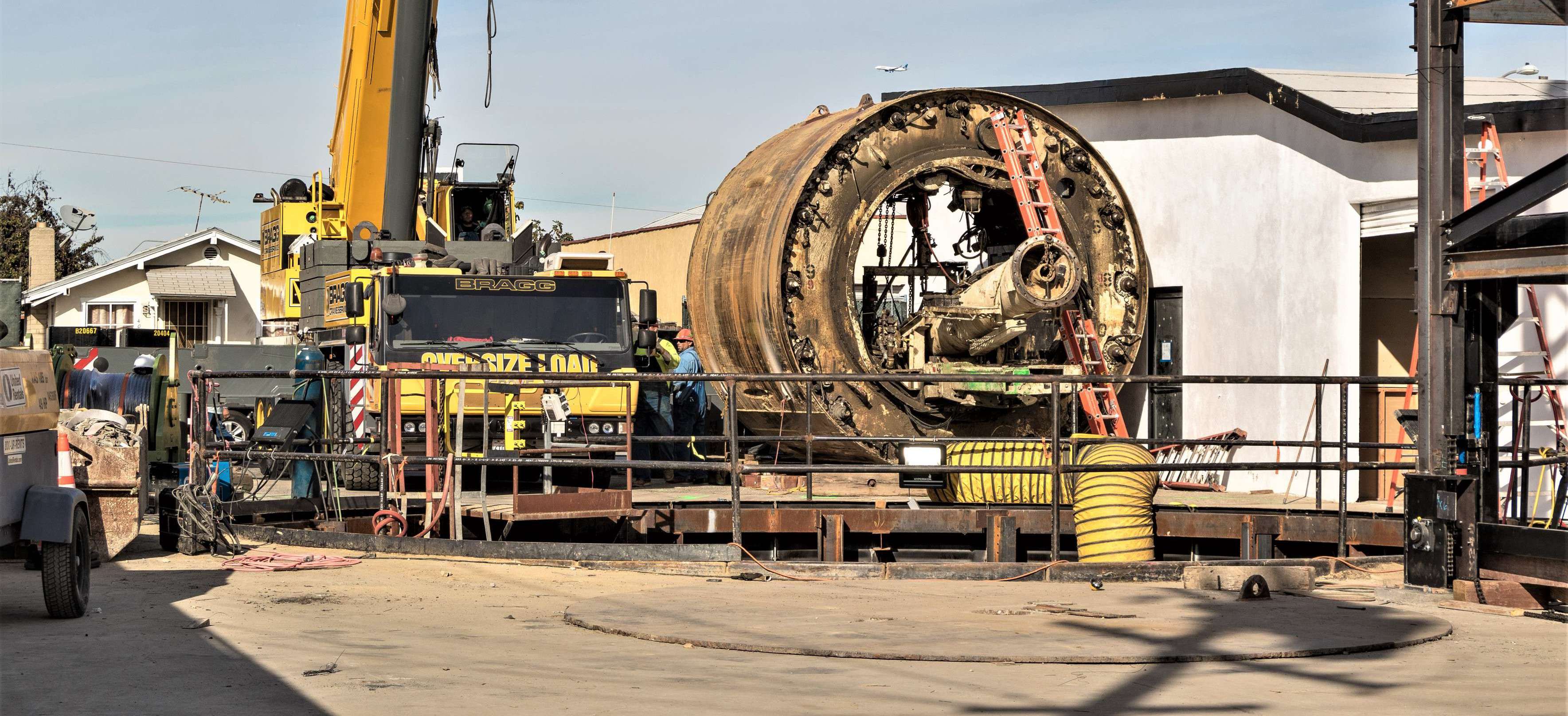

News
Elon Musk’s Boring Company extracts TBM segments as tunnel debut nears
On November 27, a large crew of Boring Company employees and contractors converged upon the company’s Praire Avenue work site, home of a number of recent milestones for the tunneling startup’s 2-mile long test tunnel situated beneath Hawthorne, California. Just a handful of blocks away from SpaceX’s main rocket factory, The Boring Co. completed the removal of its first tunnel boring machine (TBM), allowing the company to begin cleaning up the site, preparing it for the installation of a brand new elevator shaft capable of transporting vehicles or custom sleds into or out of the tunnel.
The extraction of Godot, the tunneling startup’s first TBM, was shared by the company on its official Twitter account. Godot is a conventional TBM, and during the company’s information session earlier this year, Elon Musk noted that the machine would be succeeded by Line-Storm, which is “essentially a hybrid between a conventional boring machine and Proof-Rock, a fully Boring Company-designed machine.” Being electric-powered, Proof-rock is expected have 3x more power and operate 10-15x times faster than Godot.
Godot (our 1st TBM) is out of the ground! Getting excited for Hawthorne test tunnel opening in a few weeks pic.twitter.com/5DF2sDtmIo
— The Boring Company (@boringcompany) November 28, 2018
On the same day as the TBM removal began, news broke that The Boring Company had settled with a number of Los Angeles-based complainants and chosen to cancel a proposed extension of the test tunnel expected to run under Sepulveda Boulevard. Counter to a narrative coming out of several media outlets that TBC had effectively canceled an important tunnel against the company’s will, Elon Musk clarified that the actual explanation for the change in plans was largely positive, with the company believing that it no longer needs additional practice thanks to experience gained through the construction of its first test tunnel.
Instead of pursuing the Sepulveda tunnel extension, The Boring Company instead believes that it can and should move directly to a more ambitious network of tunnels to crisscross subterranean Los Angeles, known as the Dugout Loop thanks to the inclusion of Dodger Stadium as a primary destination.
This is completely backwards. Based on what we’ve learned from the Hawthorne test tunnel, we’re moving forward with a much larger tunnel network under LA. Won’t need a second test tunnel under Sepulveda.
— Elon Musk (@elonmusk) November 29, 2018
Amidst the Boring Company’s preparations for the December 10 opening party of its Hawthorne test tunnel, the site of the Prairie Ave pit, which is expected to be the location of the Boring Company’s prototype garage-elevator concept, has shown lots of activity. Just recently, Teslarati photographer Pauline Acalin was able to capture images of multiple semi-trucks loading and transporting extricated TBM segments.
Based on the photographs we acquired, dozens of employees and/or contractors were present during the TBM extraction. The removal and transportation of the TBM segments from the Prairie Ave. pit appear to have been completed in ~24 hours from start to finish as well, as other members of the Teslarati team who visited the area not long after the photos were taken noted that the boring machine segments have already been transported elsewhere when they arrived.
- The Boring Company began removing Godot, its first tunnel boring machine, on Nov. 27 and completed the removal the following day. (Pauline Acalin)
The Boring Company began removing Godot, its first tunnel boring machine, on Nov. 27 and completed the removal the following day. (Pauline Acalin)
The extraction of Godot from the Prairie Ave. site bodes well for The Boring Company’s planned operations in the future. Conventional tunneling practices, after all, usually involve leaving expensive TBM components such as the cutting head underground after work is complete due to high costs associated with their retrieval. In classic Elon Musk fashion, the Boring Company has opted for reusability instead, seemingly using its prototype garage-elevator concept as an exit point for its TBM segments.
The experience gained by The Boring Company in its Hawthorne test tunnel would help the tunneling startup tackle its most ambitious project to date — Chicago’s upcoming downtown to O’Hare high-speed transport line, which is expected to break ground as soon as the project’s permits are completed. Updates about the Chicago project have been scarce so far, though photographs taken by Teslarati photographers suggest that a gantry for the Chicago tunnel line, as well as what appears to be a next-generation TBM, is under construction.
Here’s a little video we made to commemorate our work covering The Boring Company.
Elon Musk
Tesla investors will be shocked by Jim Cramer’s latest assessment
Jim Cramer is now speaking positively about Tesla, especially in terms of its Robotaxi performance and its perception as a company.

Tesla investors will be shocked by analyst Jim Cramer’s latest assessment of the company.
When it comes to Tesla analysts, many of them are consistent. The bulls usually stay the bulls, and the bears usually stay the bears. The notable analysts on each side are Dan Ives and Adam Jonas for the bulls, and Gordon Johnson for the bears.
Jim Cramer is one analyst who does not necessarily fit this mold. Cramer, who hosts CNBC’s Mad Money, has switched his opinion on Tesla stock (NASDAQ: TSLA) many times.
He has been bullish, like he was when he said the stock was a “sleeping giant” two years ago, and he has been bearish, like he was when he said there was “nothing magnificent” about the company just a few months ago.
Now, he is back to being a bull.
Cramer’s comments were related to two key points: how NVIDIA CEO Jensen Huang describes Tesla after working closely with the Company through their transactions, and how it is not a car company, as well as the recent launch of the Robotaxi fleet.
Jensen Huang’s Tesla Narrative
Cramer says that the narrative on quarterly and annual deliveries is overblown, and those who continue to worry about Tesla’s performance on that metric are misled.
“It’s not a car company,” he said.
He went on to say that people like Huang speak highly of Tesla, and that should be enough to deter any true skepticism:
“I believe what Musk says cause Musk is working with Jensen and Jensen’s telling me what’s happening on the other side is pretty amazing.”
Tesla self-driving development gets huge compliment from NVIDIA CEO
Robotaxi Launch
Many media outlets are being extremely negative regarding the early rollout of Tesla’s Robotaxi platform in Austin, Texas.
There have been a handful of small issues, but nothing significant. Cramer says that humans make mistakes in vehicles too, yet, when Tesla’s test phase of the Robotaxi does it, it’s front page news and needs to be magnified.
He said:
“Look, I mean, drivers make mistakes all the time. Why should we hold Tesla to a standard where there can be no mistakes?”
It’s refreshing to hear Cramer speak logically about the Robotaxi fleet, as Tesla has taken every measure to ensure there are no mishaps. There are safety monitors in the passenger seat, and the area of travel is limited, confined to a small number of people.
Tesla is still improving and hopes to remove teleoperators and safety monitors slowly, as CEO Elon Musk said more freedom could be granted within one or two months.
News
Tesla launches ultra-fast V4 Superchargers in China for the first time
Tesla has V4 Superchargers rolling out in China for the first time.

Tesla already has nearly 12,000 Supercharger piles across mainland China. However, the company just initiated the rollout of the ultra-fast V4 Superchargers in China for the first time, bringing its quick-charging piles to the country for the first time since their launch last year.
The first batch of V4 Superchargers is now officially up and running in China, the company announced in a post on Chinese social media outlet Weibo today.
The company said in the post:
“The first batch of Tesla V4 Superchargers are online. Covering more service areas, high-speed charging is more convenient, and six-layer powerful protection such as rain and waterproof makes charging very safe. Simultaneously open to non-Tesla vehicles, and other brands of vehicles can also be charged. There are more than 70,000 Tesla Superchargers worldwide. The charging network layout covers 100% of the provincial capitals and municipalities in mainland China. More V4 Superchargers will be put into use across the country. Optimize the charging experience and improve energy replenishment efficiency. Tesla will accompany you to the mountains, rivers, lakes, and seas with pure electricity!”
The first V4 Superchargers Tesla installed in China are available in four cities across the country: Shanghai, Zhejiang, Gansu, and Chongqing.

Credit: Tesla China
Tesla has over 70,000 Superchargers worldwide. It is the most expansive and robust EV charging network in the world. It’s the main reason why so many companies have chosen to adopt Tesla’s charging connector in North America and Europe.
In China, some EVs can use Tesla Superchargers as well.
The V4 Supercharger is capable of charging vehicles at speeds of up to 325kW for vehicles in North America. This equates to over 1,000 miles per hour of charging.
Elon Musk
Elon Musk hints at when Tesla could reduce Safety Monitors from Robotaxi
Tesla could be reducing Safety Monitors from Robotaxi within ‘a month or two,’ CEO Elon Musk says.

Elon Musk hinted at when Tesla could begin reducing Safety Monitors from its Robotaxis. Safety Monitors are Tesla employees who sit in the front passenger seat during the driverless rides, and are there to ensure safety for occupants during the earliest rides.
Tesla launched its Robotaxi fleet in Austin last Sunday, and after eight days, videos and reviews from those who have ridden in the driverless vehicles have shown that the suite is safe, accurate, and well coordinated. However, there have been a few hiccups, but nothing that has put anyone’s safety in danger.
A vast majority — close to all of the rides — at least according to those who have ridden in the Robotaxi, have been performed without any real need for human intervention. We reported on what was the first intervention last week, as a Safety Monitor had to step in and stop the vehicle in a strange interaction with a UPS truck.
Watch the first true Tesla Robotaxi intervention by safety monitor
The Tesla and UPS delivery truck were going for the same street parking space, and the Tesla began to turn into it. The UPS driver parallel parked into the spot, which was much smaller than his truck. It seemed to be more of an instance of human error instead of the Robotaxi making the wrong move. This is something that the driverless cars will have to deal with because humans are aggressive and sometimes make moves they should not.
The Safety Monitors have not been too active in the vehicles. After all, we’ve only seen that single instance of an intervention. There was also an issue with the sun, when the Tesla braked abnormally due to the glare, but this was an instance where the car handled the scenario and proceeded normally.
With the Robotaxi fleet operating impressively, some are wondering when Tesla will begin scaling back both the Safety Monitors and Teleoperators that it is using to ensure safety with these early rides.
CEO Elon Musk answered the inquiry by stating, “As soon as we feel it is safe to do so. Probably within a month or two.”
As soon as we feel it is safe to do so.
Probably within a month or two. We continue to improve the Tesla AI with each mile driven.
— Elon Musk (@elonmusk) June 30, 2025
Musk’s response seems to confirm that there will be fewer Teleoperators and Safety Monitors in the coming months, but there will still be some within the fleet to ensure safety. Eventually, that number will get to zero.
Reaching a point where Tesla’s Robotaxi is driverless will be another significant milestone for the company and its path to fully autonomous ride-sharing.
Eventually, Tesla will roll out these capabilities to consumer-owned vehicles, offering them a path to generate revenue as their car operates autonomously and completes rides.
For now, Tesla is focusing on perfecting the area of Austin where it is currently offering driverless rides for just $4.20 to a small group of people.
-

 News5 days ago
News5 days agoTesla Robotaxi’s biggest challenge seems to be this one thing
-

 News2 weeks ago
News2 weeks agoTesla confirms massive hardware change for autonomy improvement
-

 Elon Musk2 weeks ago
Elon Musk2 weeks agoElon Musk slams Bloomberg’s shocking xAI cash burn claims
-

 News2 weeks ago
News2 weeks agoTesla China roars back with highest vehicle registrations this Q2 so far
-

 News2 weeks ago
News2 weeks agoTesla features used to flunk 16-year-old’s driver license test
-

 News2 weeks ago
News2 weeks agoTexas lawmakers urge Tesla to delay Austin robotaxi launch to September
-

 News2 weeks ago
News2 weeks agoTesla dominates Cars.com’s Made in America Index with clean sweep
-

 News2 weeks ago
News2 weeks agoTesla’s Grok integration will be more realistic with this cool feature


